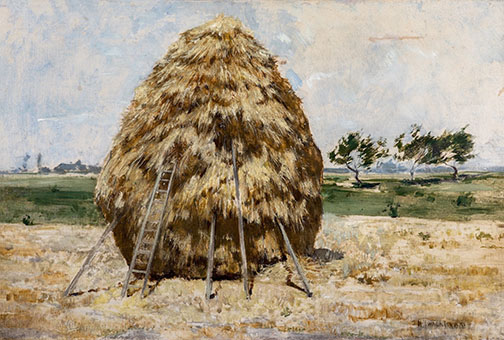Art dealers know that there are three cities you can sell to anyone – New York, Paris, and Venice. London is not as easy as you might think, and if you have a painting of, say, Cincinnati, you can sell it only in Southern Ohio. Someone in Atlanta won’t buy it. Collectors outside of New York will buy paintings of the Big Apple, but they won’t buy scenes of any other American city besides their own, no matter how well done. Paris and Venice have long been seen as romantic places, even if you’ve never been to them, but collectors won’t put on rose-colored glasses for any other city unless there’s a deep personal connection with the place.
And aside from Paris and Venice, collectors of 19th and 20th century American art generally prefer that the paintings they collect be of American scenes. A George Inness landscape of Italy sells for a fraction of what a New England scene by the artist would bring. An Albert Bierstadt painting of the Matterhorn sells for much less than a landscape of the American West. This last fact can lead to “interesting” conversations between collectors and less-than-truthful dealers.
Dealer: “And here we have a wonderful view of the Rockies by Bierstadt”
Collector: “Isn’t that a castle up there on that far mountain?”
Dealer: “Where? What are you talking about? That’s just a rock outcropping! Trust me, this is a Colorado scene!”
These thoughts are spurred by a painting I recently acquired for sale: Haystack by the American artist John Henry Twachtman (1853-1902).

Twachtman was one of the many young Cincinnati artists of German heritage who went to study at the Royal Academy in Munich (Edward Henry Potthast was another – (see my last post), and his early works have the rich and dark tonalities of the Munich School. A stay in Paris eight years later influenced his change in palette to the lighter tones of the French Impressionists.
In his Connecticut landscapes of the 1890’s, Twachtman moved into an increasingly Impressionist handling of paint, his landscapes almost approaching abstraction at times. By the time of his unexpected death at 49, Twachtman was one of the most advanced artists in America. His colleague Thomas Dewing wrote in an obituary, “He is too modern, probably, to be fully recognized or appreciated at present, but his place will be recognized in the future.”
And so it has been, though Twachtman was less sanguine about his place in art history. In an 1893 address to the students of the School of the Art Institute of Chicago, he said, “You are studying art here now, and someday some of you will become painters, and a few of you will do distinguished work, and then the American public will turn you down for second- and third-rate French painters.”
But back to my original topic – where was Haystack done? There was some thought that it might date from around 1889, when Twachtman was living near Greenwich, Connecticut and was close friends with the artist J. Alden Weir, who lived 25 miles north in Branchville. (Weir painted haystacks as well.) Some art historians, however, have pointed out that the landscape seems too flat to be near Branchville. They point to an earlier date and a European setting, perhaps in 1881 when Twachtman was on his honeymoon in Holland.
As a dealer, I would prefer that the scene be American; as a responsible member of the art history community, I will bow to whatever consensus scholars eventually reach. Either way, I find this lovely painting fascinating. There are parallels, of course, to Monet’s series of haystack paintings, which he began in 1890 although he had occasionally painted the subject earlier. The term “haystack” is probably a misnomer – while some stacks may have been composed entirely of hay waiting to be put in the barn, most stacks were made up of sheaves of wheat, barley, or oats awaiting the time when a traveling threshing machine could get to them. The “caps” were made of straw and were steeply pitched to allow rain to run off the top and away from the grain.
And yet this humble and ingenious farm invention fit well with the aims of modernist painters. Two years after Twachtman’s death, Paul Cezanne wrote to a disciple, “May I repeat what I told you here: treat nature by means of the cylinder, the sphere, the cone, everything brought into proper perspective so that each side of an object or a plane is directed towards a central point.” He could almost be describing this painting. The cone of the haystack is not completely centered in the picture, which would be boring. Instead, Twachtman places it slightly to one side, but the faint tones of the farm buildings in the far background on the left are offset by the darker tones of the closer trees on the right, pulling the composition into a satisfying central balance.
I would love to talk further with you about this painting. Call me.

